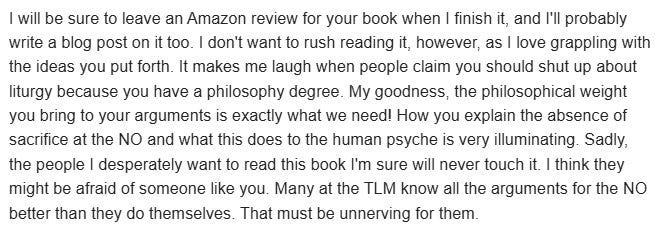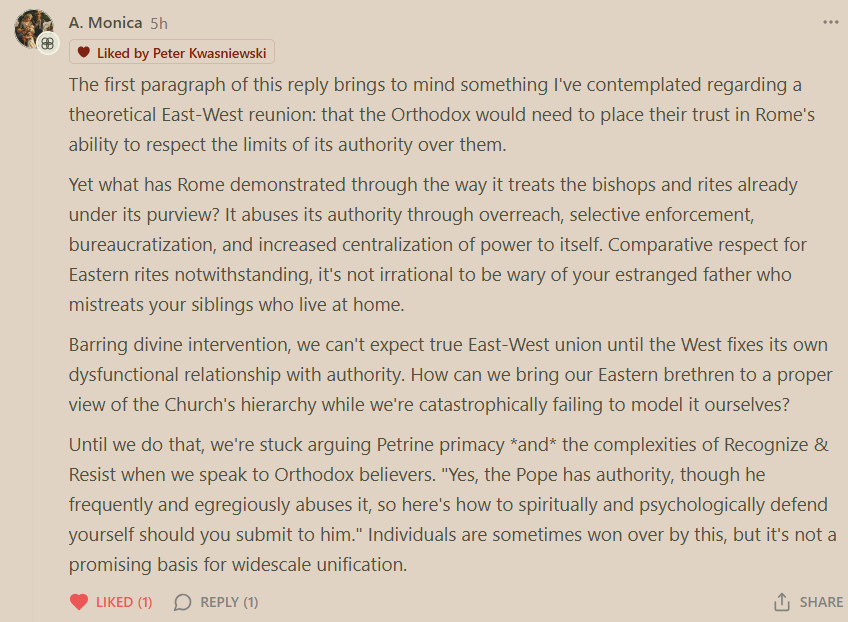Dr. K’s Weekly Roundup, April 4
Tampa rising; sanctification of time; my journey to TLM maximalism; philosophy in service of liturgy; are we aesthetes?; can anyone "own" Scripture?; thoughts on Eastern Orthodoxy; & more
Preliminaries
This week I’m out in Wyoming helping my son with a big construction project (details to be revealed later!), and this will explain why the roundup is not as thorough as it usually is — he’s been working me into the ground, and I love it! I’m not “skilled labor,” but I’ve got a pair of hands for working, and a desire to help. This project also explains why you haven’t seen any of Julian’s articles here for a while. I can only say: stay posted for a major announcement later this month about the future of Tradition & Sanity. Rest assured, it’s very positive!
Good News
Bishop Gregory Parkes of Saint Petersburg, Florida, has announced that a diocesan TLM parish in Tampa will be transformed into a diocesan Shrine for the traditional sacramental rites — the “Epiphany of Our Lord Shrine” — and will be placed in the pastoral care of the Institute of Christ the King. The change of status is effective July 1, 2025. (That’s the feast of the Most Precious Blood of Jesus, discarded by the reformers, so a very appropriate day indeed.) You can read the full statement on page 6 of this bulletin.
Bishop Parkes says he is acting in full compliance with Traditionis Custodes. Well, I don’t praise compliance with “Prison Guards of Treachery,” which has as much legal force as toilet paper. But I do praise a bishop who “works the system” in order to achieve pastoral goods. In the end, what matters is that the traditional liturgy is protected and the community gathered around it can thrive. Moreover, it is always a win when the ICKSP or FSSP can move in, because the parish then becomes a fully traditional sacramental ecosystem.
May more bishops show the same pastoral care for their flocks, which Christ has entrusted to their care, and an account of which He will demand from them on the Day of Judgment.
Liturgical Lessons
Sanctification of time
At New Liturgical Movement this week, I talk about the importance of trying to recover a Catholic notion of time — no easy task when the entire modern world has been built on a different paradigm that thwarts it.
It has struck me over the years how infrequently Catholics reflect on, or are even aware of, the difference between the secular conception of time and the sacred conception of time. Isaac Newton introduced the notion of absolute space and time, where space is seen as a giant grid of Cartesian coordinates, and time is seen as an equable ticking of a clock, all seconds, minutes, and hours being equal. This may be called temporal egalitarianism.
The premodern notion of time, in contrast, sees it as hierarchical, organic, and malleable. The day is understood to have a spiritually significant rhythm from dawn to noon to dusk to night, and each one of these parts has its own character, its own “weight” and role in the spiritual life, not to mention its function as a sign. The week has an internal dynamism emanating from the Sunday past and straining towards the Sunday to come, with certain days connected customarily to certain mysteries or saints, above all Friday’s connection to the Passion (hence, the rule of abstinence from flesh meat on the day when the flesh of God was crucified).
Into the seasons of the year the great mysteries of the Catholic faith are woven, so that the cycle of nature mysteriously symbolizes the cycle of grace, each providing a key to the other. In short, the Catholic mind sees time as differentiated by days and seasons of feasting and fasting, by Sundays and Solemnities, by memorials, novenas, and processions.
I then discuss the pivotal role of the Divine Office. (For a very similar article, albeit with more of an emphasis on time and eternity, see Robert Lazu Kmita’s “How to Touch Eternity Through Liturgical Time.”)
Scalability
At OnePeterFive, Eric Sammons makes a brisk argument as to why the TLM is “scalable” and the Novus Ordo isn’t — in other words, why you can pretty much know what you’re getting with the TLM anywhere in the world but you can’t rely on finding a reverent Novus Ordo (there’s a reason we call it a “unicorn”). What I especially appreciate here is Eric’s observations about why we can’t ever expect the unicorn to become normative.
This conclusion is one that I defend at length in Close the Workshop. In order to discuss it and related topics further, Eric invited me on to the Crisis Podcast. Our vigorous 90-minute conversation can be viewed here:
Philosophy in service of liturgy
A good friend is currently reading my new book from Angelico Press: Close the Workshop: Why the Old Mass Isn’t Broken and the New Mass Can’t Be Fixed. He writes:
I once knew a Thomist who said: “The main reason theology is in such a mess today is that its philosophical foundations have been totally eroded. Bad philosophy is like a poorly-laid foundation to a house: it doesn’t matter how beautiful or fancy the upper stories are, they will all collapse if their support is weak or lacking.”
This, of course, is what Pius X said about the Modernists: their philosophical presuppositions dissolve Catholic theology.
I find the same to be true in debates over the papacy or over liturgy: many who engage in them are positivists of one sort or another (be it magisterial positivists, patristic positivists, etc.) who cannot see the logical presuppositions and implications of various statements. An example would be the way in which the exercise of authority — any authority — is inherently bound up with the pursuit of the common good, such that power obviously used against that good is illegitimate. This is a philosophical argument presupposed to any right understanding of Vatican I’s Pastor Aeternus — or, for that matter, Vatican II’s Sacrosanctum Concilium.
The other point raised by this reader is that many of those who defend the TLM are often very well-versed in the Novus Ordo because they grew up with it, attended it for years and years, and in many cases have studied it carefully; whereas almost none of the Novus Ordo’s defenders are well-versed, from study and years of experience, in the TLM. So the debate is extremely uneven. This causes the traditionalist to feel frustrated (reasonably so) and the Novus Ordo defender to think he has “won” when he has just made a fool of himself.
Part of the reason I write the books I do is that I want to bring readers “up to speed” on the relevant liturgical issues and debates, which they might not otherwise know about or grasp the importance or implications of.
Are we aesthetes?
Another objection often flung at traditionalists is that of being “preoccupied with externals” or “mere aesthetics.” Over at Dappled Things, Fr. Michael Rennier, an artist and a priest who is sensitive to the metaphysical and spiritual weight of aesthetics, offers a very thoughtful review of Close the Workshop. In “Tradition is the guardian of beauty,” he writes:
The grace of stability allows for beauty. That which is “too pluriform, too gigantic, and too mutable,” writes Kwasniewski, cannot sustain meditative attention because when everything is in flux, beauty has no solid ground. Originality and constantly-shifting expressions of individual creativity with no reference to tradition is not something that one can surrender oneself to. It demands nothing. It asks only to gain your momentary attention before disappearing. But the discipline of a tradition? These are the conditions of greatness.
Form and stability hold an inner fire, a sacred fire. We must be very careful with the form because it is guarding precious beauty, that which we give our lives in search of and suffer a great deal to create and experience. The stability of the form is hieratic. Ultimately, it’s not about the form itself, but that to which it is united.
Read the rest at Dappled Things.
Can anyone “own” Scripture and the liturgy?
Did you know that corporations claim to legally own Scripture and the prayers of the Church in such a way that you cannot use or publish them without paying for them? Another “fruit” of the Vatican II behemothian bishop-bureaucracy! The magnitude of this problem makes Tetzel’s sale of indulgences in the early 16th century look like child’s play.
An eye-opening article by Jeff Ostrowski lays out all the information. Excerpt:
Selling indulgenced prayers is immoral. Remember that the USCCB — as well as the various shell corporations it uses to collect the lucre — isn’t selling physical books. Rather, it claims to own the substance (!) of the readings, prayers, and acclamations.... Those prayers and readings are needed by Catholics to celebrate Mass. Selling them is immoral, and those responsible are obligated to make restitution. But how will they make restitution after raking in millions of dollars for sixty years? But there’s still another problem. The effort to make money off of these sacred texts resulted in deals being struck “behind closed doors.” Many decisions—even those with monumental consequences—were made in secret. Because so many decisions were made covertly, many errors crept in. Had things been done out in the open, such errors would have been noticed and corrected by “crowd sourcing.”...
What possible good could come from allowing certain corporations to make a profit by selling our sacred Mass prayers and readings? Was the person who gave total control over the entire psalter (!) to a non-Christian company ever reprimanded?
Reason #1,215,463 to pray with the immemorial Roman Rite and bypass the behemoth.
In contrast: the Vulgate is public domain; the Douay-Rheims is public domain; the Roman Missal of 1570 and onwards is public domain. They belong to everyone.
Thoughts on the Eastern Orthodox
Last week at T&S, I published a response to Michael Warren Davis: “An Irenic Response to an Orthodox Convert’s Critique of the Papacy.” Michael has written a respectful and interesting reply: “An Orthodox Case for the Papacy.” I appreciate his friendly tone, though he has not won me over to the “primacy of honor/love” interpretation of the papal office, nor the notion that all apostles are successors of Peter and therefore each local church is complete in and of itself.
I do think, however, that the “imperialization” of the papacy and the ever-expanding reach even to the point of naming every bishop and, more recently, intervening in parish bulletins (!) is absurd and needs a serious corrective. A reader of this Substack left a comment with which I agree 100%:
A perfect illustration: an article on the Marian Friars Minor, formerly of Kentucky and now in North Carolina, whose founder was initially part of the Franciscan Friars of the Immaculate — a flourishing order destroyed by Pope Francis, shattered into a thousand pieces, some of which have regrouped as new Franciscan orders (usually existing in a shadowy canonical state due to suspicion or persecution from progressive church leaders). Reading this article, “Voices in the Wilderness (aka The Zoomer Catholic Friars of Western North Carolina),” not only gives reasons to rejoice in the workings of the Holy Spirit, but also shows how completely out of touch this pope and his lackeys are to the spiritual searchings and yearnings of Modern Man.
All that being said, Timothy Flanders writes at OnePeterFive about some of the less honest aspects of Orthodox theology and apologetics: “Church History Under the Duck Test: The Orthodox Have to Decide.”
Other Favorite Articles
A miracle in the grand old style, by which I mean something obviously totally inexplicable by natural causes, has been attributed to the intercession of Cardinal Pell. Obviously this will need to be investigated thoroughly, but with everything I know about Pell, a miracle would not surprise me in the least. May the Lord overthrow His enemies and glorify His servants.
In paintings of Our Lord and Our Lady, one often sees the presence of either apples or pears or both. David Clayton explains the beautiful symbolism in “The Apple of Her Eye.”
Mark Cornelius, at his excellent new Substack Rebuilding the Walls, has penned one of the best pieces I’ve ever read about… reading! “Tolle, lege: on restoring the heart and hearth through reading.” He explains how the Christian tradition privileges reading (or being read to, in an oral culture) as one of the highest and most formative acts of the human person, and as part of a morally, intellectually, and spiritually upright life. Additionally, in modern times, reading good literature aloud in the family is a form of necessary countercultural activity.
If models of modern feminine holiness are needed, Robert Lazu Kmita suggests that a little-known novel and its movie adaptation may help form our imaginations.
Emily Finley doubles down on her claim that romanticism is the root of our modern ills, or at least their common language:
A bottle of the fermented tea popular among hippies and crunch cons alike (I guess that would put me in the latter camp) says on its label: “WORDS OF ENLIGHTENMENT: ‘YOU ARE MEANT TO SHINE IN THE LIGHT AND THE DARKNESS. LIKE THE SUN AND THE MOON, YOU ARE HERE TO BLESS THE WORLD WITH YOUR BRILLIANCE.’”
Such sentimental claptrap is so ubiquitous that it’s like the air we breath, but it’s worth considering where it came from, because it goes way beyond all these empty slogans on consumer goods. This romantic sentimentalism has infected everything from the family to foreign policy. More than Marxism, feminism, post-modernism, or liberalism, the spirit of Romanticism has permeated the cultural landscape of the West. All other “isms” seem to be colored by Romanticism — “One Ring to rule them all.”
Hear, hear! Always good to see the Integrated Humanities Program (of John Senior et al. fame) receiving the attention it deserves, as it does in Walker Larson’s “Born in Wonder: A Humanities Program Taught Us How to Change the World Through Literature”:
The IHP, located at Kansas University, surged to unexpected success and popularity during the 1970s, changing hundreds if not thousands of lives. This set the program and its authors on a collision course with the university authorities and initiated a desperate fight to keep the program from “death by administration” due to accusations of proselytism and, in the end, the institution’s hatred for the program’s adherence to objective truth. A deeply human story of the struggle for the truth, the adventure of the IHP stands out from 20th-century pedagogical history like a flaming candle in the midst of the darkness of the age. There is much we can discover in its light that will aid us in the fight that continues in our own day.
The story of the IHP contains human interest and drama, a groundbreaking pedagogical model usable by contemporary educators, and a profound philosophical message that the world desperately needs to hear. I am convinced that the professors of the IHP discovered a key to restoring modern man to his senses, rebuilding an acknowledgment of objective reality (the lack of which is rotting our civilization), and preparing the way for the fruitful penetration of grace.
In “They Searched for the Angels and Found Themselves,” Robert Keim offers us a wonderful essay on angelology:
[In ancient and medieval Christianity] I see angels playing an essential role as the glorified counterpart of human society—that is, as a class of heavenly beings who, speaking the language of poetry rather than explication, communicate to human beings a more profound and perfect knowledge of our nature, our earthly existence, and our eternal destiny. Let us go further: in their uniquely vivid and enchanting way, the angels show us nothing less than what it truly is to be a human being—and if in losing the angels we lose also our humanity, then we are lost indeed, for in order to be Christian, one must first be human.
I remember in a graduate course on the anthropology of St. Thomas that we started first with the treatise on angels from the Prima Pars. The professor said: “Thomas does some really heavy lifting here, and if we read it, then the treatise on man will make a lot more sense.” And he was quite right.
Over at The Catholic Herald, George Young gives us a glowing review of Sebastian Morello’s Mysticism, Magic, and Monasteries. He says it “offers a brilliant counter-narrative to contemporary inversions.” Indeed it does!
Thank you for reading, and may God bless you!








The CCWatershed article about "Pay to Pray" lectionaries is especially interesting in light of the Lepanto Institute's article titled "The Hymnal Industrial Complex," which is linked in the footnote of the CCWatershed article. That was an eye-opening read. The suspect incentives and scandalous conduct within the sacred text/hymnal industry is yet another depressing facet of modern Church woes.
It's all egregious enough if you're a traditionalist who believes the faithful have the right to opt out by using the traditional texts and materials. It's a whole other level of sinister and extortionate if you're a Church official who believes the faithful are morally required to use the modern texts.
Unfortunately the skulduggery of the fallen, inhabiting the upper echelons of the Church hierarchy, is so commonplace that it barely is deemed newsworthy. I was reminded of the 9th Century origins of Peter's Pence in Anglo-Saxon England this week whilst reading Nicholas Orme's 'Going to Church in Medieval England '. The incredible sacrifices our forebears made to support the Church, at times of absolute² poverty, are inspirational. And yet, how common we see scandal now: Peter's Pence, the highway robbery of whoring Liturgical and Sacred Texts etc.